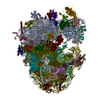+検索条件
-Structure paper
| タイトル | A molecular network of conserved factors keeps ribosomes dormant in the egg. |
|---|---|
| ジャーナル・号・ページ | Nature, Vol. 613, Issue 7945, Page 712-720, Year 2023 |
| 掲載日 | 2023年1月18日 |
 著者 著者 | Friederike Leesch / Laura Lorenzo-Orts / Carina Pribitzer / Irina Grishkovskaya / Josef Roehsner / Anastasia Chugunova / Manuel Matzinger / Elisabeth Roitinger / Katarina Belačić / Susanne Kandolf / Tzi-Yang Lin / Karl Mechtler / Anton Meinhart / David Haselbach / Andrea Pauli /  |
| PubMed 要旨 | Ribosomes are produced in large quantities during oogenesis and are stored in the egg. However, the egg and early embryo are translationally repressed. Here, using mass spectrometry and cryo-electron ...Ribosomes are produced in large quantities during oogenesis and are stored in the egg. However, the egg and early embryo are translationally repressed. Here, using mass spectrometry and cryo-electron microscopy analyses of ribosomes isolated from zebrafish (Danio rerio) and Xenopus laevis eggs and embryos, we provide molecular evidence that ribosomes transition from a dormant state to an active state during the first hours of embryogenesis. Dormant ribosomes are associated with four conserved factors that form two modules, consisting of Habp4-eEF2 and death associated protein 1b (Dap1b) or Dap in complex with eIF5a. Both modules occupy functionally important sites and act together to stabilize ribosomes and repress translation. Dap1b (also known as Dapl1 in mammals) is a newly discovered translational inhibitor that stably inserts into the polypeptide exit tunnel. Addition of recombinant zebrafish Dap1b protein is sufficient to block translation and reconstitute the dormant egg ribosome state in a mammalian translation extract in vitro. Thus, a developmentally programmed, conserved ribosome state has a key role in ribosome storage and translational repression in the egg. |
 リンク リンク |  Nature / Nature /  PubMed:36653451 / PubMed:36653451 /  PubMed Central PubMed Central |
| 手法 | EM (単粒子) |
| 解像度 | 2.3 - 3.2 Å |
| 構造データ | EMDB-13111, PDB-7oya: EMDB-13112, PDB-7oyb: EMDB-13113, PDB-7oyc: EMDB-13114, PDB-7oyd:  EMDB-13115: Cryo-EM structure of the 80S rabbit ribosome from reticulocyte lysate  EMDB-14588: Cryo-EM map of the Xenopus egg dormant ribosome |
| 化合物 |  ChemComp-ZN:  ChemComp-MG: |
| 由来 |
|
 キーワード キーワード | RIBOSOME / translation / embryo / zebrafish / maternal / Dap1 / Dap1b / Habp4 / Eif5a / Eef2b / Eef2 / DapL1 / egg / Xenopus |
 ムービー
ムービー コントローラー
コントローラー 構造ビューア
構造ビューア 万見文献について
万見文献について













